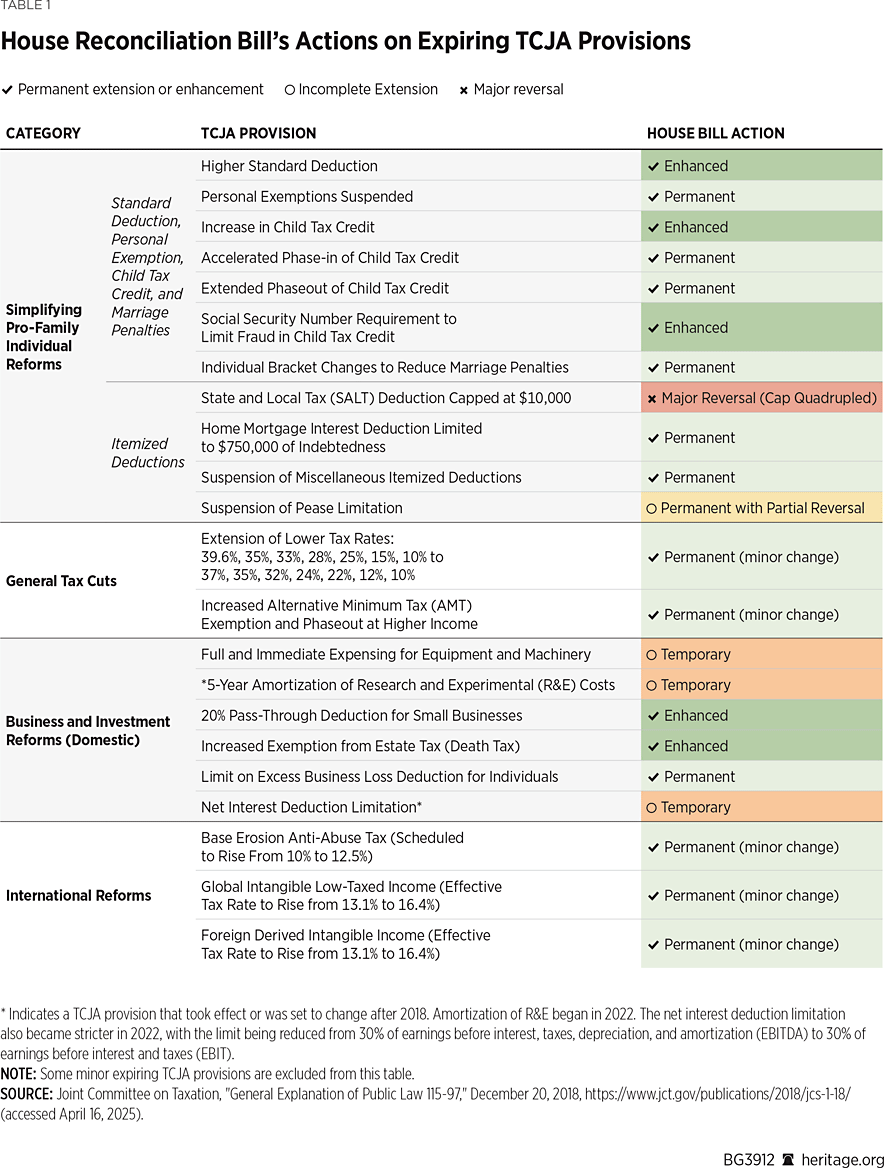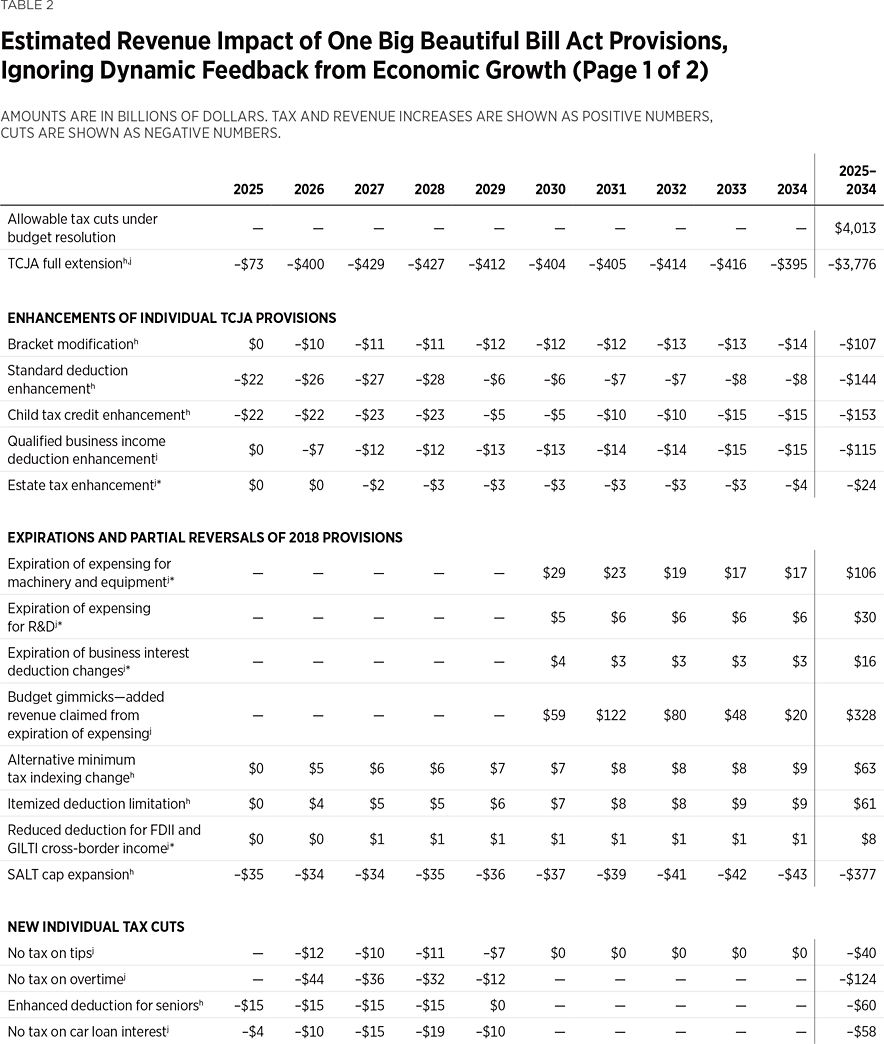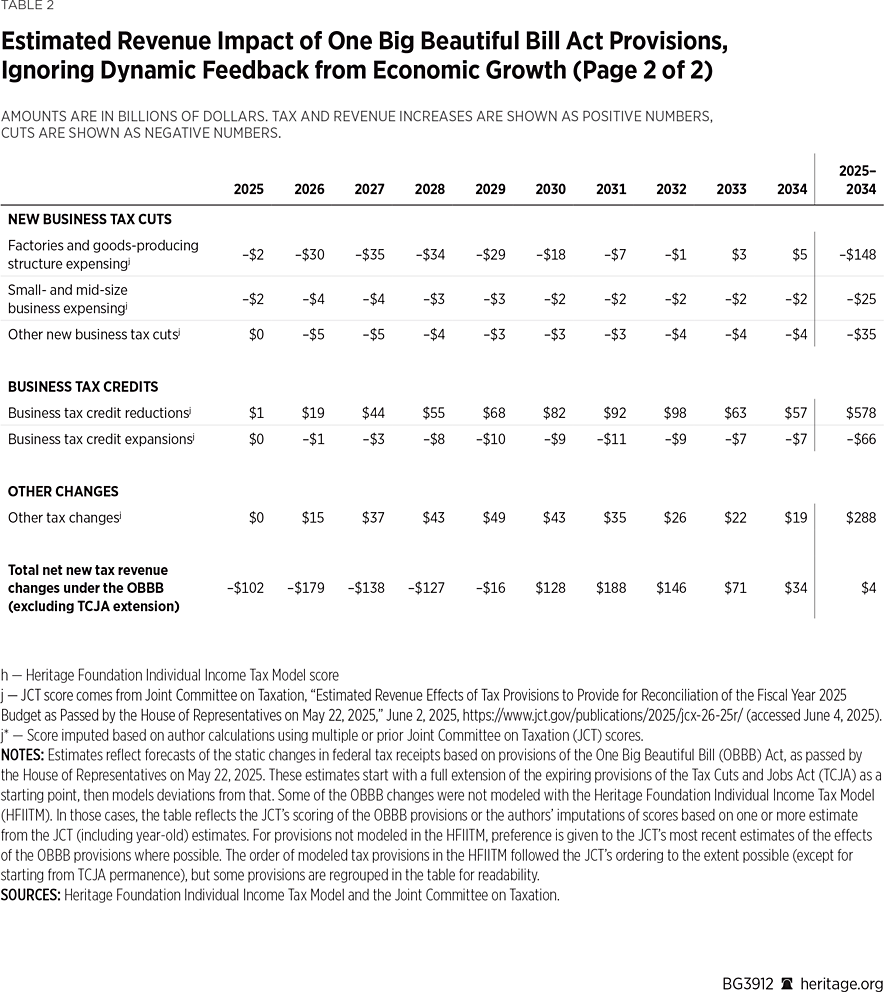The House of Representatives passed its version of the fiscal year (FY) 2025 budget reconciliation bill on May 22 by the narrow margin of 215 to 214, with one Member voting present. The bill, titled the One Big Beautiful Bill Act (OBBB), now moves to the Senate, which will have the opportunity to amend or rewrite the legislation. Significant changes to the legislation in the Senate are likely. Assuming the reconciliation bill that passes out of the Senate is different from the House version, the two chambers will then have to reconcile any differences before the legislation can move to a final vote in both chambers, and finally to the President’s desk to be signed into law.
One of the key points of contention for lawmakers is the OBBB’s quadrupling of the cap on the state and local tax (SALT) deduction from $10,000 to $40,000. The SALT deduction acts as a subsidy for higher state and local government spending and taxes. A higher SALT deduction would primarily reduce the taxes of high-income individuals residing in and around a few high-tax cities in blue states. Moreover, it does so in a way that would produce little economic growth and would have the unfortunate effect of encouraging states and cities to tax and spend more.REF
Expanding the SALT cap would represent a significant reversal of the 2017 Tax Cuts and Jobs Act (TCJA), the signature tax reform of President Donald Trump’s first term. The TCJA enacted the SALT cap as a key base-broadener, using the added revenues from the cap to enable pro-growth tax reforms. The cap on SALT, combined with the TCJA’s increase in the standard deduction, also reduced the amount of time that individuals spend complying with the individual tax code—fewer than 10 percent of all individual taxpayers itemize their taxes under the TCJA.REF
Because of its large budgetary effects, a major expansion in the SALT cap could severely limit any new tax cuts that Congress can pass within the constraints of the FY 2025 budget resolution. Indeed, because of budget constraints, the version of the bill that passed in the House would only temporarily extend the most pro-growth expiring TCJA provision: full and immediate expensing for equipment and machinery. Similarly, the House bill’s other two most critical growth provisions—full and immediate expensing for new factories and goods-producing structures and a return to full expensing for research and development (R&D)—would expire after 2029.
The Budget Resolution Math
The reconciliation process must follow the budget resolution instructions (as passed by the House and Senate on April 10), which tell each House and Senate committee, and the two chambers as a whole, the levels of allowable new deficits or required deficit reductions within their respective jurisdictions.REF The budget reconciliation process generally relies on deficit scores from the Joint Committee on Taxation (JCT) and the Congressional Budget Office (CBO). For purposes of determining conformity to the budget resolution, the JCT and CBO scoring is generally static, meaning they do not account for any additional revenues that may be achieved from any economic growth produced or any other macroeconomic effects of the tax or spending changes. As a result, the JCT’s scoring tends to overstate the deficit impact of pro-growth tax reforms. The deficit-impact scores described in this Backgrounder refer to static scores in order to be consistent with the JCT approach that guides the reconciliation process, though the critical role of economic growth in ensuring sustainable debt and deficit levels should be emphasized.REF This Backgrounder ends with a discussion of the potential growth effects of recommended changes to the legislation.
The FY 2025 House budget resolution instructions to which Congress agreed would allow $4 trillion in tax cuts (including extensions of expiring tax cuts) if paired with at least $1.5 trillion in spending cuts across all committees. Any additional tax cuts beyond $4 trillion would have to be balanced by additional (dollar-for-dollar) spending cuts.
Analysis using The Heritage Foundation Individual Income Tax Model (HFIITM) estimates that a full extension of the TCJA would reduce revenues (on a static basis) by approximately $3.8 trillion, accounting for most of the $4 trillion in tax cuts allowable under the House budget instructions. Adding a quadrupled SALT cap would add $377 billion more in scored 10-year deficit impact, more than exhausting the limited budget space and thus necessitating further spending cuts (beyond $1.5 trillion) or new revenue raisers.REF Other new tax reductions, such as “no tax on tips” and “no tax on overtime” put further pressure on Congress to identify offsetting spending cuts and revenue raisers, or else resort to short-term extensions that make deficits appear smaller on paper.
The One Big Beautiful Bill Act Tax and Spending Package
The version of the OBBB that narrowly passed the House meets the parameters of the budget resolution by including $1.513 trillion in net deficit reductions from the 10 non-tax spending committees, based on CBO scoring.REF This enables the Ways and Means Committee (the House’s tax-writing committee) to include up to $4.013 trillion in net tax cuts (including extensions). The Ways and Means Committee also included provisions to pare back about $578 billion in tax subsidies, mostly subsidies related to renewable energy and electric vehicles that were passed or expanded under President Joe Biden’s Inflation Reduction Act (IRA).REF These reduced and eliminated tax subsidies provide lawmakers with some additional space for tax cuts.
The core of the OBBB is the extension of the 2017 TCJA provisions. Most of the 2017 tax provisions would be extended permanently under the House bill. The largest new tax-related provision in the bill, by scored deficit impact, is the increased SALT cap. Other notable tax changes include: an enhancement of the child tax credit; a temporary increase in the standard deduction; an increased “pass-through” deduction for small businesses; temporary expensing for goods-producing structures; the reinstatement of full expensing for research and development; and new deductions for tips, overtime, car loans, and senior citizens.REF
Expanded SALT Subsidies
The OBBB would partially reverse the TCJA cap on SALT deductions:
- The current $10,000 SALT deduction cap would quadruple to $40,000 beginning in 2025;
- The SALT cap would begin to phase down for taxpayers with incomes above $500,000, settling at the existing $10,000 cap for those making $600,000 or more; and
- The OBBB would also introduce a new 1 percent annual increase in both the SALT cap and the income threshold at which the phasedown begins.
According to the HFIITM, increasing the SALT cap as described above would increase deficits in the 10-year budget window by approximately $377 billion compared to extending the current cap.REF The static deficit impact of the expanded SALT subsidies would be nearly equal to the combined deficit impact of all the individual TCJA enhancements described above. (The OBBB’s enhancements to TCJA tax brackets, standard deduction, child tax credit, and the death tax exemptions were estimated to total $428 billion over 10 years.)REF
Drawbacks of the SALT Deduction. Generous targeted tax deductions come at the cost of lower general tax rates or broader tax reforms to encourage growth and produce higher wages for all. Targeted tax deductions should thus generally be avoided. Targeted deductions certainly should not be used to incentivize harmful behaviors, such as state and city governments raising taxes. Therefore, on policy grounds, quadrupling the SALT deduction cap to $40,000 is unjustifiable.
One may consider a single taxpayer with $400,000 in income who pays 10 percent of his income in state and local taxes. Since the taxpayer would be in the 35 percent federal tax bracket, a $40,000 SALT deduction would reduce his income by $14,000. The equivalent tax reduction for the same individual could be accomplished by reducing his average tax rate by 3.5 percentage points. Lower tax rates would allow taxpayers to keep more of each dollar they earn, incentivizing work and productivity. The higher SALT deduction does not meaningfully incentivize work effort and productivity. In fact, the OBBB SALT cap design would discourage work effort and productivity for taxpayers earning between about $500,000 and $600,000, because it includes a 30 percent phaseout of the SALT deduction cap, which can act like an extra 10.5 percent marginal tax for taxpayers in the phaseout.
There are numerous drawbacks to a higher SALT deduction:
- It would crowd out positive, pro-growth tax reforms. The increase in the SALT cap uses up about $377 billion in budget space that could go toward more economically beneficial changes, such as making the expensing provisions permanent.
- It would make individual taxes more complicated. The TCJA moved the individual tax system away from reliance on itemization of deductions. A quadrupled SALT cap would lead to a significant increase in itemizing.
- It would encourage high-tax states and cities to tax and spend even more. The SALT deduction shelters influential high-income taxpayers from fully bearing the cost of big government and high taxes in their states and localities, enabling governments to expand with less resistance.REF
- It would dampen fiscal competition between states. Since the TCJA capped SALT deductions, at least 23 states have cut their top income tax rate, compared to only five that have raised it.REF
- It would concentrate benefits in and near a few large cities in high-tax states. As shown in Map 1, in 2017 (before the SALT cap was added) half of all SALT deductions were claimed by taxpayers in a small number of counties located between the Washington, DC, and Boston metro areas, in the Chicago metro area and near three cities on the Pacific coast.REF

Permanent TCJA Extensions and Enhancements
The OBBB would permanently extend most of the expiring provisions of the TCJA, as mentioned. The key exceptions are the SALT deduction cap and three expensing-related provisions, which would be extended only through 2029.REF
Following is a list of certain enhancements of TCJA provisions that would go beyond a simple extension under the OBBB. The estimated (static) deficit effects of the OBBB’s enhancement provisions are shown in parentheses. Individual income tax scores are based on the HFIITM unless specified otherwise. The enhancements are:
- An additional year of cost-of-living adjustments applied to all but the top ordinary income tax bracket, resulting in a small reduction in most individuals’ average tax rate ($107 billion);
- The standard deduction, which nearly doubled under the TCJA, would increase by another $1,000 for unmarried filers, $1,500 for heads of household, and $2,000 for married joint filers through 2028 ($144 billion);
- The child tax credit (CTC), which doubled under the TCJA, would increase from $2,000 to $2,500 through 2028. In 2029, the CTC would revert to the 2024 level ($2,000), but with permanent cost-of-living adjustments dating back to 2024 added ($153 billion);REF
- Social Security numbers would be required of parents to be eligible for the CTC;
- The TCJA’s 20 percent pass-through deduction for small businesses would increase to a 23 percent pass-through deduction ($115 billion);REF and
- The death tax exemption amount, which was doubled under the TCJA, would further increase from about $14 million to $15 million ($24 billion).REF
Combined, the enhancements of the TCJA provisions would use up about $543 billion in budget space in the 10-year window.
Temporary TCJA Extensions
The OBBB would temporarily return to the cost-recovery rules that were in place in 2018:
- Companies would be allowed to fully and immediately deduct qualifying costs related to equipment and machinery, instead of following drawn-out depreciation schedules of up to 20 years;
- Similarly, the five-year amortization of R&D costs would revert to full and immediate expensing; and
- The more relaxed business interest deduction cap that was in place through 2021 would be reinstated, removing implicit penalties against companies that take out loans to purchase depreciable business assets, such as new factories and equipment.
These three expensing-related provisions would expire at the end of 2029. Compared to allowing the TCJA to expire outright, the JCT scored these three provisions as increasing the deficit by $37 billion, $23 billion, and $40 billion, respectively ($99 billion in total). However, compared to a full and permanent extension of the TCJA, the House tax writers received scores from the JCT government scorekeepers suggesting deficit reductions of $229 billion and $106 billion, respectively, for equipment and machinery expensing and R&D ($328 billion in total when also including the 2030–2034 score for the business interest deduction limitation) over the 10-year budget window from the early expirations of the expensing provisions.REF
Allowing the expensing provisions to expire for five years (on paper) offsets 77 percent of government scorekeepers’ reported deficit impact from the five-year extension of the expensing provision. This budget quirk is an artifact of how the changes in cost recovery provisions affect the timing of deductions, as the acceleration of current deductions can reduce future tax deductions. However, it is also an artifact of a budget scorekeeping process that allows the current Congress to claim deficit savings for actions that a future Congress would control (in this case, whether it would allow damaging tax increases to take effect in 2029 or whether it would extend the expensing provisions).
The real-world effect of putting expiration dates on the expensing provisions is that the legislation would produce far less economic growth (as discussed further below), arguably making the legislation’s deficit concerns greater, not smaller. In the long run, the additional revenues from the economic growth produced by fixing these economic penalties to business investments would offset much, if not all, of the short-run deficit impact of making these provisions permanent. This shows the pitfalls of writing legislation to target favorable scores from government scorekeepers instead of targeting real budgetary and economic goals.

New Tax Cuts for Tips, Overtime, Domestic Car Loans, Seniors, and Factories
The OBBB includes several new individual deductions, which qualifying taxpayers would be allowed to claim regardless of whether they use the standard deduction or whether they itemize. These new deductions include:
- A deduction for cash tips received in “traditionally tipped” occupations, excluding tips paid to “highly compensated employees” as defined by the Internal Revenue Code ($40 billion);REF
- A deduction for overtime compensation (excluding “highly compensated employees”) that is required to be paid under the Fair Labor Standards Act of 1938 (deducting the “half” in “time and a half”) ($124 billion); and
- A deduction for interest paid on loans for passenger cars, sports utility vehicles, pickup trucks, vans, motorcycles, passenger trailers, and recreational vehicles that are assembled in the United States ($58 billion).REF
The OBBB also includes a bonus deduction for senior citizens. This change would be in addition to the enhanced standard deduction described above, or in addition changes to itemized deductions, as it would be available to seniors whether or not they itemize:
- The bonus deduction for senior citizens would increase by $4,000, or $8,000 in the case of married joint filers who have both reached age 65 ($60 billion).REF
The estimated combined static revenue effect of the three “no tax on” provisions (tips, overtime, and car loans) plus the increased deduction for seniors are more than 25 percent smaller than the expansion in the SALT cap.
The OBBB includes one especially notable new tax cut for businesses:
- Full and immediate expensing would extend to costs related to new factories and other goods-producing structures placed in service through 2029 ($148 billion).REF
Other Tax Changes. Altogether, the OBBB includes about 120 different sections related to tax. Other changes not described above include:
- Changes to the cap on itemized deductions,
- A significant increase in the endowment tax for large colleges and foundations,
- A new tax on remittances,
- Taxes to retaliate against foreign countries imposing digital service taxes or undertaxed profit taxes against U.S. companies,
- Tightened restrictions on non-citizens qualifying for benefits through the tax code,
- Expansions of health savings accounts, and
- Creation of individual savings accounts for newborns known as “Trump accounts.” (See Table 2 and the appendix for more details.)


Analysis of the OBBB’s Tax Changes and Key Areas for Improvement
The OBBB would prevent many TCJA provisions from expiring in 2026, a key goal of the Trump electorate. However, as written, the bill leaves substantial room for improvement as it moves to the Senate for debate.
The Senate should improve on the OBBB by reducing the SALT cap so that it is reduced to, or close to, the $10,000 level from the TCJA. The Senate should also immediately terminate all the IRA’s green tax credits, instead of allowing gradual phaseouts and generous grandfathering of existing projects. The extra budget space afforded by these changes could, in turn, be used to make the critical expensing provisions permanent.
The OBBB would reverse some of the simplifying gains of the TCJA which saved tens of millions of Americans from the time-consuming hassle of itemizing.
The OBBB also lacks major structural improvements on the business side, except for the termination of some of the IRA’s green tax credits and the temporary allowance of full expensing for factories and goods-producing structures. Moreover, because the House bill would allow all expensing provisions (for goods-producing structures, equipment and machinery, R&D, and the interest deduction cap) to expire in four years, businesses and entrepreneurs would face substantial uncertainty. Some building projects take more than four to five years to complete because of permitting and regulatory challenges, and so temporary expensing for structures may still leave some businesses reluctant to make the major capital investments that would drive the economic resurgence that lawmakers seek.
Why Making the Expensing Provisions Permanent Matters
Business taxes should only apply to the profits that companies earn, so deductions for legitimate business expenses are appropriate. Denying or delaying the deductibility of ordinary and legitimate business expenses causes companies to be taxed on amounts that are greater than their profits. (Delayed deductions are costly to companies unless borrowing costs are zero.) Rising interest rates exacerbate problems of delayed cost recovery.
The 20-year and 39.5-year depreciation schedules that some equipment and structures would face if the TCJA expired and the OBBB did not pass could be a major deterrent to companies investing in those assets. The comparatively gradual depreciation schedules for capital costs in the United States would make it relatively more costly to build and invest in the U.S. than many other countries around the world. The Tax Foundation estimates that even in 2022, with the TCJA still in effect, the United States’ cost-recovery rules effectively only allowed companies to recover 67.7 percent of their actual costs on capital expenses, less than the Organization for Economic Co-operation and Development average of 70.7 percent.REF The U.S. rules, according to Tax Foundation’s analysis, were particularly unfavorable for the cost recovery of buildings.
Since businesses in some industries have profit margins of only a few percentage points, even small deviations from the proper tax base can have a big effect on companies’ bottom lines.REF Delayed cost recovery through drawn out depreciation and amortization schedules severely distorts and discourages investment decisions.
Temporary, short-term changes to cost recovery rules are insufficient to assure companies and entrepreneurs that the investing environment in the United States will remain favorable throughout the duration of major projects and undertakings. By doing what it takes to lock in full and immediate expensing permanently, Congress could ensure that small businesses, in particular, have the stability and tax simplicity that will give them a chance to succeed.
Although estimates of the economic impacts vary, there is considerable consensus among researchers that making full expensing for equipment and machinery, R&D, and goods-producing structures permanent offers great economic growth potential. Researchers have found that capital stock investments are particularly sensitive to proper cost recovery.REF Studies have verified these findings using a variety of methods including industry-level, state-level, and firm-level differences in the availability of expensing provisions.REF
The investments that proper expensing would help to facilitate—such as modern factories, expanded refineries, new machinery and robotics, and the development of new technologies—would drive worker productivity higher and lead to more and better jobs. Making expensing provisions permanent would likely drive greater productivity gains and wage growth over time by reducing the misallocation of capital investments for arbitrary tax rules (such as sunsetting expensing provisions).REF While there is always uncertainty in economic forecasting, the dynamic growth from proper cost recovery rules could offset much, if not all, of the short-term deficits that may result from the change.REF
Recommendation for the Senate
The OBBB’s increase in the SALT deduction is bad policy. Expanding the subsidization of high state and local taxes would reverse one of the major policy successes of President Trump’s first term. The SALT deduction increase stands in the way of making the most pro-growth provisions considered in the OBBB permanent.
- The Senate should reject a massive increase in the SALT cap, terminate or at least accelerate the phaseouts of the remaining IRA tax credits, and use the additional budget space from these changes to make each of the expensing provisions permanent.
Conclusion
Finding the budget space to lock in all the expensing provisions once and for all is the fiscally prudent course. Each in a series of short-term tax extensions may allow smaller scored deficit impacts than simply making the provisions permanent. However, such budget gaming creates uncertainty and fails to confront budget trade-offs. Implementing full and immediate expensing is the proper tax policy and would drive strong economic growth, buying time for lawmakers to tackle the very real and pressing problem of unsustainable projected future deficits. Sacrificing growth provisions in the name of deficit reduction is the wrong approach.
These simple changes of swapping SALT subsidies and green tax credits for full and immediate expensing would help to ensure that America is the best place in the world to work and do business in the coming years and decades. These changes could dramatically improve the incentive for businesses and entrepreneurs to build factories, refineries, and agricultural structures, to develop new technologies, and to equip their workers with the tools they need to succeed, while simultaneously encouraging state and local governments to keep their own taxes in check.
Preston Brashers is Research Fellow for Tax Policy in the Grover M. Hermann Center for the Federal Budget at The Heritage Foundation. Brian O’Quinn is Computational Economist in the Center for Data Analysis at The Heritage Foundation.
Appendix
Methodology for The Heritage Foundation Individual Income Tax Model
The estimates were produced by a custom microsimulation model developed by The Heritage Foundation to analyze individual income tax reforms.
The model starts with an IRS-produced sample of tax returns.REF For each observation in the sample, the program simulates the computation of taxes and utilizes principles of statistics to estimate aggregate revenues. However, since the IRS dataset is censored and missing values, the model imputes information as needed to estimate a tax filer’s net income tax.
The IRS does not release these datasets until seven years have passed. Thus, to study taxes over time, the model must generate a sequence of artificial samples to form the basis of tax return calculations beyond the original dataset year. This process (“evolution”) is governed by statistics, such as the total number of households filing jointly and the sum of reported wages. For past years, these statistics are known, and for later years these statistics are forecasted.
The evolution process takes the original sample and modifies it, as conservatively as possible, such that it satisfies the specified statistics. The result is an artificial sample that captures observed or predicted trends while maintaining the heterogeneity present in the original sample.
The model then uses this artificial sample to calculate taxes for the sample’s year. The program cycles through these processes of evolution and tax calculation until it has simulated taxes for the 10-year budget window and then uses principles of statistics to produce aggregate revenue estimates.
Table 2 Details
Table 2 shows the static revenue scores for certain specific provisions of the OBBB and scores for certain groups of changes. This section details the provisions that are grouped together in Table 2. The listed provisions mostly correspond to the line items in the JCT’s table of estimates:
The TCJA full extension includes: extension of changes to rates and brackets; extension of increased standard deduction; termination of deduction for personal exemptions; extension of TCJA child tax credit; extension of deduction for qualified business income; extension of TCJA’s increase in estate and gift tax exemption amount; extension of increased alternative minimum tax exemption and phaseout thresholds; extension of limitation on deduction for qualified residence; termination of miscellaneous itemized deductions; termination of Pease limitation; termination of qualified bicycle commuting reimbursement exclusion; extension of exclusion and deduction for moving expenses; extension of limitation on wagering losses; extension of increased limitation on contributions to Achieving a Better Life Experience (ABLE) accounts and permanent enhancement; extension of Savers credit allowed for ABLE contributions; extension of rollovers from qualified tuition programs to ABLE accounts permitted; extension of treatment of certain individuals performing services in the Sinai Peninsula; extension of exclusion from gross income of student loans discharged on account of death or disability; exclusion for certain employer payments of student loans under educational assistance programs; extension of rules for treatment of certain disaster-related personal casualty losses; extension of deduction for foreign-derived intangible income and global intangible low-taxed income; extension of base erosion minimum tax amount; renewal of opportunity zones; extension of bonus depreciation for equipment and machinery; deduction for domestic research and experimental expenditures; modified calculation of adjusted taxable income for purposes of business interest deduction; and extension of the $10,000 SALT cap.
Qualified business income deduction enhancement includes: modification to qualified business income deduction phaseout; increase in qualified business income deduction rate to 23 percent; modification to indexing for qualified business income deduction; and business development corporation income qualifies for the qualified business income deduction.
Other new business tax cuts include: repeal of revision to de minimis rules for third-party network transactions; increase in threshold for requiring information reporting with respect to certain payees; repeal of excise tax on indoor tanning services; exclusion of interest on loans secured by rural or agricultural real property; treatment of certain qualified sound-recording productions; increase in gross receipts threshold for small manufacturing; global intangible low-taxed income determined without regard to certain income derived from services performed in the Virgin Islands; restoration of taxable real estate investment trust (REIT) subsidiary asset test; income from hydrogen storage, carbon capture added to qualifying income of certain publicly traded partnerships treated as corporations; and removal of silencers from the National Firearms Act.
Business tax credit reductions include: termination of previously owned clean vehicle credit and termination of clean vehicle credit; termination of qualified commercial clean vehicle credit; termination of alternative fuel vehicle refueling property credit; termination of energy-efficient home improvement credit; termination of residential clean energy credit; termination of new energy-efficient home credit; phaseout of and restrictions on clean electricity production credit; phaseout of and restrictions on clean electricity investment credit; restrictions on carbon-oxide sequestration credit; phaseout of and restrictions on zero-emission nuclear power production credit; termination of clean hydrogen production credit; phaseout of and restrictions on advanced manufacturing production credit; phaseout of credit for certain energy property; and changes to employee retention credit.
Business tax credit expansions include: enhancement of employer-provided child care credit; extension and enhancement of paid family and medical leave credit; modifications to low-income housing tax credit; and extension and modification of clean fuel production credit.
Other changes from the Ways and Means Committee include all other scored changes under the Ways and Means Committee’s jurisdiction in the OBBB, as included in JCT estimates JCX-26-25R.



